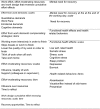Need for recovery in relation to effort from work and health in four occupations
- PMID: 31620862
- PMCID: PMC7007885
- DOI: 10.1007/s00420-019-01476-7
Need for recovery in relation to effort from work and health in four occupations
Abstract
Objective: To examine three levels of need for recovery (NFR) after work in relation to effort from work demands, demand compensatory strategies, effort-moderating or -reversing resources, and health including health behaviors. A further purpose was to examine occupational characteristics determining NFR.
Methods: 5000 engineers, carpenters, nurses, and home care nurses were invited to participate. NFR k-means clusters were calculated from 1289 participants. The effect from three levels of NFR regarding demands, compensatory strategies, resources at work, health, and health behaviors was examined using analysis of variance (ANOVA) and post hoc analysis. Prevalence ratios (PRs) of suboptimal health for three levels of NFR were calculated using Poisson regression. Linear stepwise multiple regression predictors explaining NFR were examined also occupation wise.
Results: NFR centroids at 5.8/33, 13.1/33, and 21.0/33 points were identified. ANOVA showed corresponding effects from NFR levels on work demands and compensatory strategies. The inversed proportion concerned levels of resources at work. Only the low NFR cluster negated regular health effects. The other two cluster groups also repeatedly worked while ill and presented PRs concerning health effects from 1.9 to 3.9 when compared to the low NFR group. Making good quality work, recovery opportunities, and thinking of work when off work were the most important predictors of NFR among 1289 participants with also occupation-wise interpretable profiles.
Conclusions: Three levels of NFR meant corresponding levels of work demands, work-demand compensatory strategies, and unfavorable health behaviors. An inversed proportion of resources related to the same levels of NFR. Low NFR meant no regular health effects which could guide limit values regarding salutary NFR. Important predictors of NFR were resources making a good quality work, recovery opportunities, and reversely effort from rumination when off work. Occupation-wise predictors could guide interventions.
Keywords: Occupations; Psychosocial work characteristics; Recovery; Rumination; Stress; Work-related fatigue.
Conflict of interest statement
The authors declare that they have no conflict of interest.
Figures


References
-
- Allen J, Fultz G, Huntoon J, Brethour JR. Pathological dissociative taxon membership, absorption, and reported childhood trauma in women with trauma-related disorders. J Trauma Dissoc. 2002;3:89–110. doi: 10.1300/J229v03n01_07. - DOI
-
- Aronsson G, Lindh T (2004) Långtidsfriskas arbetsvillkor. En populationsstudie. Rapport Arbete och hälsa vetenskaplig skriftserie. Stockholm, Arbetslivsinstitutet
-
- Aronsson G, Svensson L, Gustafsson K. Unwinding, recuperation, and health among compulsory school and high school teachers in Sweden. Int J Stress Manag. 2003;10(3):217–34. doi: 10.1037/1072-5245.10.3.217. - DOI
MeSH terms
Grants and funding
LinkOut - more resources
Full Text Sources
Medical

